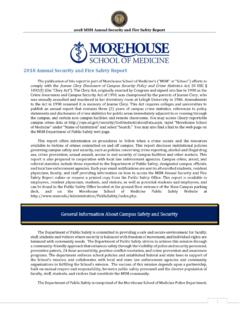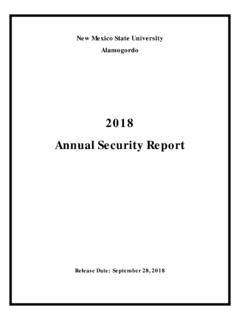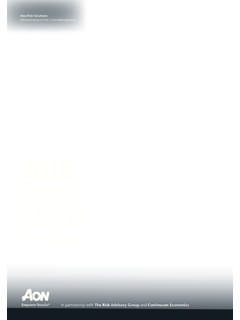Transcription of Annual Economic Report 2018: Editorial - bis.org
1 IxBIS Annual Economic Report 2018 Annual Economic Report 2018 : EditorialStarting this year, the traditional BIS Annual Report comprising an analysis of the global economy and a presentation of the BIS s activities will be split into two separate publications. In addition, the Economic part, renamed Annual Economic Report , has been restructured. The first three chapters review global developments, prospects and risks, while two special chapters focus on topical issues, with analyses of macroprudential frameworks and cryptocurrencies. This Editorial summarises the content and key global economy: developments, prospects and risksIt is now 10 years since the Great Financial Crisis (GFC) engulfed the world.
2 At the time, following an unparalleled build-up of leverage among households and financial institutions, the world s financial system was on the brink of collapse. Thanks to central banks concerted efforts and their accommodative stance, a repeat of the Great Depression was avoided. Since then, historically low, even negative, interest rates and unprecedentedly large central bank balance sheets have provided important support for the global economy and have contributed to the gradual convergence of inflation towards objectives. Still, central banks were largely left to bear the burden of the recovery, with other policies, not least supply side structural ones, failing to take the baton.
3 These actions by central banks helped lay the groundwork for the resumption of growth that we now see. But, in the process, they have been one factor behind the legacy of swollen private and public sector balance sheets and higher debts that shapes the road ahead. As the global economy reaches or even exceeds potential, it is time to take advantage of the favourable conditions to put in place a more balanced policy mix to promote a sustainable expansion. However, the path ahead is a narrow dividends of past policies were clearly in evidence in the year under review a vintage one for the global economy (Graph and Chapter I).
4 The expansion strengthened and broadened. Global growth rates were roughly on a par with pre-crisis long-term averages, and the expansion was highly synchronised across countries (Graph , left-hand panel). Unemployment continued to decline, reaching multi-decade lows in a number of economies, including some of the largest (centre panel). Overall, headline inflation rates moved closer to central bank objectives, although core inflation remained more subdued. In fact, the year capped a steady improvement in the global economy that has been evident for some time. As already noted two Annual Reports ago, the picture then was considerably better than the gloomy rhetoric indicated.
5 And in last year s Report we highlighted how talk of secular stagnation had given way to renewed optimism and a revival of animal the next couple of years, consensus forecasts see the trend continuing, marking one of the longest postwar expansions (Graph and Chapter I). Despite the softer patch in the first quarter of 2018 and some jitters in emerging market economies (EMEs) (see below), the forecasters central scenario is still for global growth to exceed potential, reducing unemployment further, with economies testing capacity limits. Investment is expected to strengthen, boosting productivity over time. And fiscal expansion should provide additional near-term stimulus: quite xBIS Annual Economic Report 2018apart from the measures in the United States, the OECD foresees an easier fiscal stance in around three quarters of its members this year and next.
6 At the same time, inflation is forecast to edge current scenario is somewhat unusual in the postwar period (Chapter I). It is not common to anticipate such strong growth so late in the expansion, when capacity constraints start biting, with only modest signs of an inflation threat. The reasons for this picture are much debated. There may be more slack than meets the eye: the crisis may have left a legacy of discouraged workers ready to re-enter the labour force as conditions improve; the investment pickup may be erasing some of the crisis scars, raising potential; and longer-term demographic factors and pension reforms may also be at work, as indicated by the widespread increase in participation rates among the older segments of the population, with the United States a notable exception.
7 Moreover, as emphasised in previous Annual Reports, the persistent influence of globalisation and technological advances on inflation should not be underestimated, not least through their impact on workers and firms pricing the expansion, and partly as a result of the heavy reliance on monetary policy to support the post-crisis recovery, financial conditions once again played a key role in the year under review (Chapters I and II). At least until recently, global financial conditions remained very easy. In fact, they loosened further even as US monetary policy proceeded along its very gradual and well anticipated normalisation path.
8 True, long-term US Treasury yields moved up. But term premia remained historically low and equity price valuations quite rich, except when assessed in relation to the prevailing low interest rates. Importantly, credit spreads have been unusually compressed, often at or even below pre-GFC levels, and the corresponding markets appear to have become increasingly illiquid. Moreover, for most of the year under review the US dollar depreciated, supporting buoyant financial conditions especially in EMEs, which post-crisis have borrowed heavily in that currency and during the past year saw strong portfolio inflows. These buoyant conditions in EMEs, however, reversed more recently (see below).
9 BIS Annual Economic Report 1 The global economy strengthens further as inflation converges Graph growth1, 2 Unemployment rates2, 3 Inflation1, 4 yoy changes, per cent; sa Pe r cent; sa Per cent In the left-hand panel, the dots indicate C onsensus Economics forecasts for 2018 ; the dashed lines indicate 1982 2007 averages. 1 Weighted averages bas ed on GD P and PPP exchange rates . 2 For the euro area, weighted average across individual countries before 1995. 3 Weighted averages based on labour force levels; definitions may vary across countries. 4 Consumer prices. Sour ces : IMF, International Financial Statistics and World Economic Ou tlook; OECD, Main Economic Indicators; CEIC; Cons ens us Economics; Datastream; Global Financial Data; national data; BIS calculations.
10 9630 3 618130803989388839876541813080398938883 GlobalAEsEMEs86420 218151209xiBIS Annual Economic Report 2018In the Report , we also assess the risks ahead in some detail (Chapter I). The conclusion is that medium-term risks are material, although there are cross-country differences. In some respects, the risks mirror the unbalanced post-crisis recovery and its excessive reliance on monetary policy. Where financial vulnerabilities exist, they have been building up, in their usual gradual and persistent way. More generally, financial markets are overstretched, as noted above, and we have seen a continuous rise in the global stock of debt, private plus public, in relation to GDP (Graph ).



















